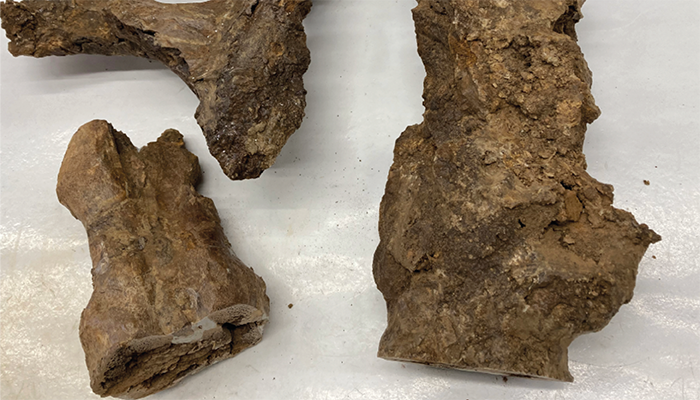
The fossil is an exceptionally well preserved Edmontosaurus sacrum
Credit: University of Liverpool
An interdisciplinary study led by researchers at the University of Liverpool has revealed new evidence for the presence of endogenous collagen in fossilized dinosaur bones. Using a combination of advanced analytical techniques, the team detected and quantified remnants of collagen from a well-preserved Edmontosaurus sacrum from the Upper Cretaceous Hell Creek Formation in South Dakota.
It was previously thought that collagen, the main structural protein in vertebrate bones, degrades over millions of years. However, the use of liquid chromatography-tandem mass spectrometry (LC-MS/MS) revealed hydroxyproline, a key collagen-associated amino acid, in acid-digested samples. Bottom-up proteomics further confirmed the presence of specific collagen peptides, matching sequences previously identified in Brachylophosaurus canadensis and Tyrannosaurus rex.
The team used Fourier-transform infrared spectroscopy (FTIR) to support their results, which revealed a weak carbonyl absorption band indicative of organic residues. Additional tests using cross-polarized light microscopy (XPol) demonstrated birefringence in localized regions of the fossil, which were consistent with the optical properties of collagen-bound bioapatite in fresh bone. The preservation pattern was comparable to artificially degraded modern turkey bone samples, suggesting that some fossilized regions still retained structural collagen remnants.
The findings contribute to the broader discussion on biomolecular preservation in fossils and the potential for ancient protein sequencing, with the study’s lead author Steve Taylor claiming the results “have far-reaching implications,” in a recent press release.
“Firstly, it refutes the hypothesis that any organics found in fossils must result from contamination. Secondly, it suggests that cross-polarized light microscopy images of fossil bones, collected for a century, should be revisited. These images may reveal intact patches of bone collagen, potentially offering a ready-made trove of fossil candidates for further protein analysis.”
The authors suggest future research will focus on refining detection techniques, exploring the role of diagenetic factors, and testing additional fossil samples to assess the reproducibility of the team’s findings. “This could unlock new insights into dinosaurs – for example revealing connections between dinosaur species that remain unknown.”




